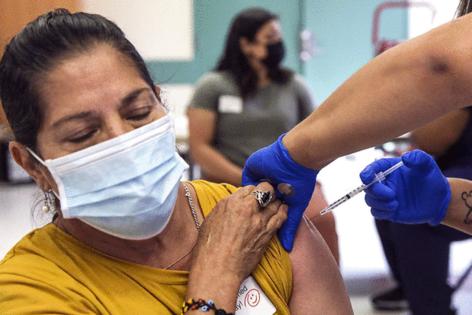How long will California's COVID surge continue? 5 things to know
Published in News & Features
LOS ANGELES – The coronavirus has muscled its way back into headlines in recent weeks amid a summer wave of the illness and growing difficulties in getting the vaccine, as well as efforts by the Trump administration that could make getting inoculated harder for some people.
The summer increase is decidedly smaller than what California and the U.S. saw during the pandemic years. Still, it has sidelined many who came down with COVID-19 and has some health officials concerned.
Here are five things to know:
1) We are not out of the woods yet.
According to data released Friday, there are now 14 states with "very high" levels of coronavirus detected in their wastewater — California, Texas, Florida, North Carolina, Indiana, South Carolina, Alabama, Louisiana, Connecticut, Utah, Nevada, Idaho, Hawaii and Alaska, as well as the District of Columbia.
The rate at which COVID-19 lab tests are confirming infection also continues to rise statewide and in the Los Angeles area. For the week that ended Aug. 30, California's COVID test positivity rate was 12.83%, up from 7.05% for the week that ended Aug. 2. In L.A. County, the positive test rate was 14.83%, up from 9.33%.
Coronavirus levels in the sewage of Northern California's most populous county, Santa Clara, were still considered "high" as of Friday.
2) But there may be signs we're reaching the peak.
In Orange County, the COVID-19 positive test rate was 13.1%. That's below the prior week's rate of 18% but still higher than the rate for the week that ended Aug. 2, which was 10.8%.
In San Francisco, the test positivity rate was 8.1% for the week that ended Aug. 30. That's down from the prior week's figure of 8.7% but higher than the 5.8% reported for the week that ended Aug. 2.
In addition, wastewater data in L.A. County show that coronavirus levels declined slightly from the prior week.
3) Overall, the summer spike has been generally mild.
Despite a new variant, there hasn't been much severe disease from COVID-19 this summer.
COVID hospital admissions in California have been increasing — with the latest rate of 3.93 admissions per 100,000 residents for the week ending Aug. 30, up from 2.38, from the week ending Aug. 2.
But they remain relatively low statewide and in L.A. County. The number of L.A. County residents seeking care for COVID-related illness, or who have been hospitalized, "is quite a bit lower than during summer surges in 2023 and 2024," the county's Department of Public Health said.
Overall, this summer hasn't seen COVID activity to the extent of a year ago, when the state experienced its worst summer wave since 2022.
4) But the fall and winter are an open question.
A mild summer wave could create conditions for problems later in the year.
In July, the state Department of Public Health said that scientists anticipated California would see either a stronger summer COVID wave or a more significant winter wave.
5) There is still massive confusion over the future of COVID vaccines.
Under the leadership of Health and Human Services Secretary Robert F. Kennedy Jr. — a vaccine skeptic — federal agencies have in effect made it more difficult to get vaccinated against COVID-19 this year. The Food and Drug Administration has "approved" COVID-19 vaccines only for those 65 and older, as well as younger people with underlying health conditions.
That means, across the country, people younger than 65 interested in getting the COVID-19 vaccine must now either consult with a healthcare provider or "attest" to a pharmacy that they have an underlying health condition. It's a potential hurdle that can make getting the vaccine more difficult and, some health experts worry, prompt even more Americans to eschew getting vaccinated.
On Thursday, Hawaii joined California, Washington and Oregon in launching the West Coast Health Alliance: an interstate compact meant to provide science-based immunization guidance as an alternative to the CDC.
It was not immediately clear, however, whether the formation of the West Coast Health Alliance would make it easier for people to get COVID-19 vaccines at the nation's largest pharmacy retailers, where many people get their shots.
Mainstream medical groups, such as the American Academy of Pediatrics and the American College of Obstetricians and Gynecologists, are offering their own recommendations to advise individuals and families on what vaccines they should get.
©2025 Los Angeles Times. Visit at latimes.com. Distributed by Tribune Content Agency, LLC.







Comments